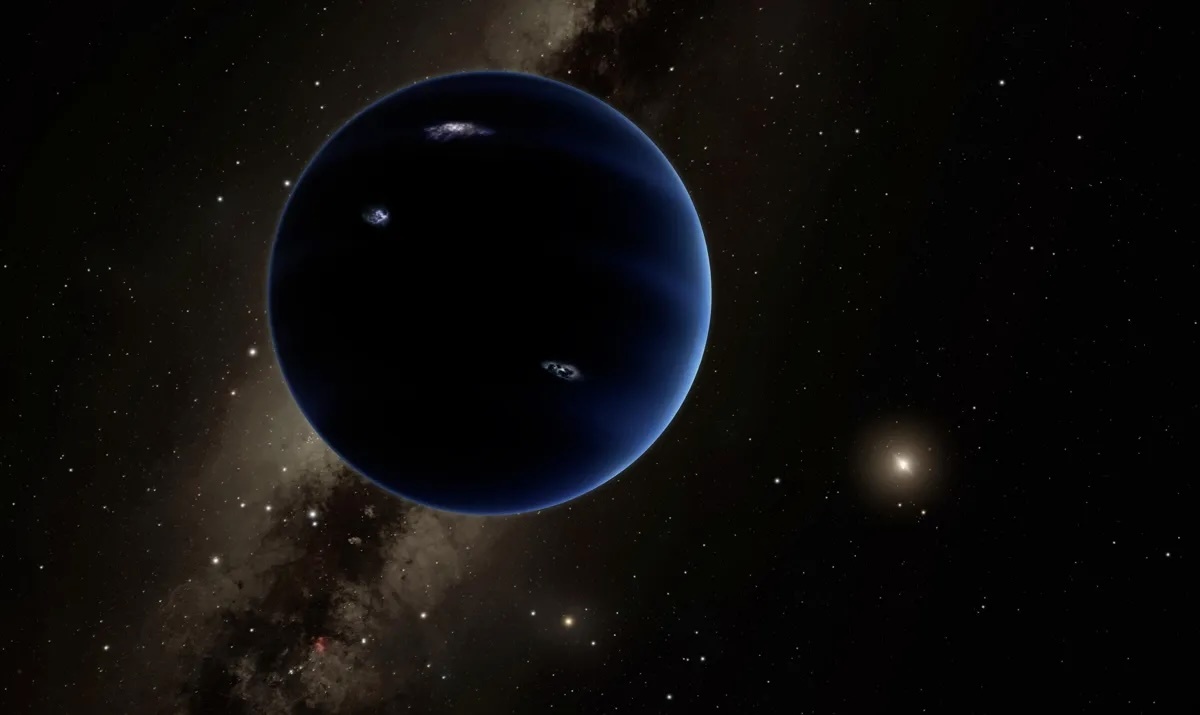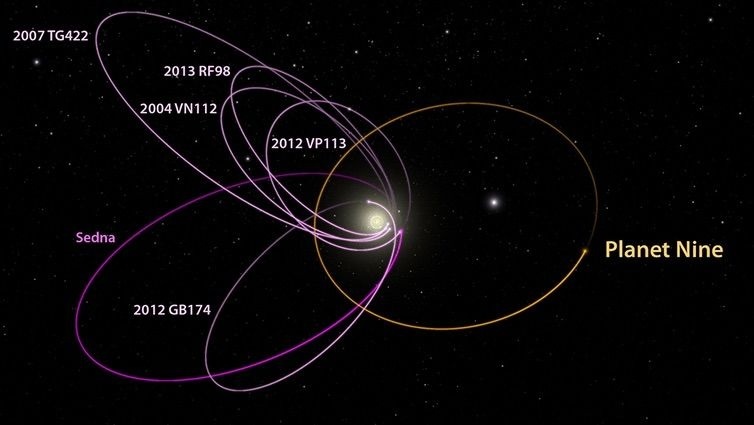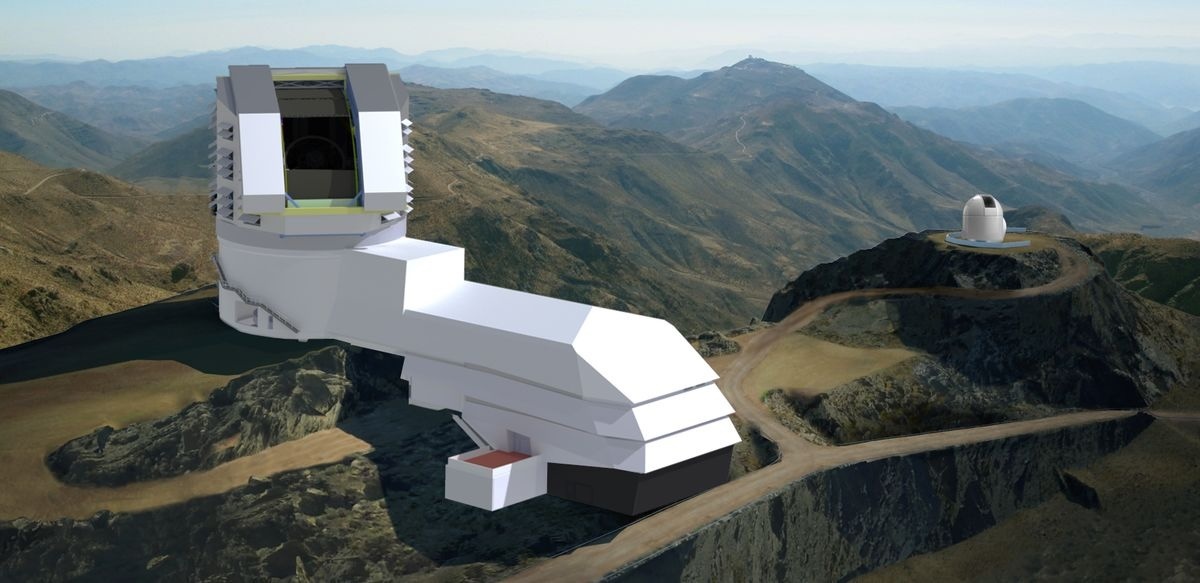2.05.2024
Something is throwing icy bodies past Neptune, and scientists have an interesting idea about what it might be.

More evidence for a hypothetical extra planet lurking in the most distant reaches of our solar system has come to light — and the clues are associated with icy bodies that cross the orbit of Neptune while traversing long, looping paths around the sun.
Planet Nine, as the predicted planet is referred to, was first postulated in 2016 by Caltech's Konstantin Batygin and Michael Brown, the latter having also discovered the dwarf planet Eris in 2005. Their original evidence predominantly focused on the clustering of trans-Neptunian objects (TNOs), which are objects that spend the majority of their orbits farther from the sun than Neptune is. That's quite far. More specifically, the duo had zoomed in on TNOs with high inclinations, meaning the objects orbited the sun at steep angles to the ecliptic plane.
Because the solar system's contents formed from a disk around the sun, we would expect the orbits of everything orbiting the sun to keep relatively close to the plane of that disk. However, some don’t — and the team infers this as evidence that Planet Nine's gravity could be pulling the objects out of the ecliptic and bunching them together in highly inclined orbits that share similar "apsides" (closest and most distant points in their orbits around the sun) and which are orientated with a similar tilt away from the ecliptic.
However, some astronomers remained skeptical, arguing that what Batygin and Brown saw as clustering is just an illusion caused by observational bias. The Caltech duo dispute this, and have actually now published a paper that focuses particularly on observations of low-inclination TNOs that don't cluster, but which still have peculiarities.
These icy TNOs are strange because they spend most of their life hundreds of times farther from the sun than Earth is, but their orbits are so elongated that they swoop in and spend a short while closer to the sun than Neptune, which is just 30 times farther from the sun than Earth. "With this work, we looked at objects with long-period orbits but which also strongly interact with Neptune, specifically those that cross Neptune'’s orbit," Batygin told Space.com.
This doesn't include every object that crosses Neptune's orbit, to be clear. Pluto is a good counterexample. Like Pluto, the majority of TNOs don't have orbits that are as elongated as the ones included in the team's new research. Rather, most TNOs have trajectories that keep them relatively close enough to Neptune for extended periods of time such that they can be controlled by the ice giant's gravity.
The team, however, concerned itself only with those TNOs that get hundreds of astronomical units away from Neptune's gravitational tides, where Planet Nine can exert influence over them — if it so exists, of course. Because these studied objects come from all directions close to the ecliptic plane, without exhibiting any clustering behavior, the same claim of bias leveled at previous evidence regarding high-inclination, clustering TNOs does not hold.
The studied TNOs, and any on similar paths, don't spend too much time in their orbits; over the course of millions of years the gravity of the azure blue ice giant Neptune inevitably bats them away, scattering them far and wide and sometimes even out of the solar system entirely. This means that whatever is sending TNOs onto Neptune-crossing orbits is doing so continuously. There must be an ongoing process in place to keep the TNO supply replenished. This means that the culprit can't be something that happened in the distant past, like a star passing particularly close by. It has to be something that still exists.
There are two scenarios that could regularly place TNOs on long, looping orbits that cross Neptune's path. One scenario is that of the galactic tide, which is the gravitational tidal force of the Milky Way galaxy all around us acting on objects within the Oort Cloud, which lies far away beyond Neptune. These objects only loosely feel the sun's gravity due to their distance from our host star, but the galactic tide can usher them closer towards Neptune.

The existence of a roughly Neptune-mass Planet Nine could explain why the few known extreme trans-Neptunian objects seem to be clustered together in space. The diagram was created using WorldWide Telescope. (Image credit: Caltech/R. Hurt (IPAC))
The other scenario — perhaps the more interesting one — is that the gravity of Planet Nine is perturbing these Oort Cloud objects enough that they tread closer to Neptune over time.
Batygin and his team — Michael Brown, Alessandro Morbidelli of the Observatoire de la Côte d’Azur in Nice, France, and David Nesvorny of the South-west Research Institute in Boulder, Colorado — performed two sets of simulations using observational data of real, low-inclination, Neptune-crossing TNOs to learn which scenario is more accurate.
One simulation involved a planet with a mass five times that of Earth influencing the TNOs (the simulated properties they used for Planet Nine are derived from the characteristics that best explained previous evidence such as the clustering of the high-inclination TNOs), while the other simulation had no Planet Nine at all and modeled just the galactic tide. Which would be most adept at getting TNOs to pass by Neptune?
The simulations showed that low-inclination TNOs can only regularly penetrate Neptune's orbit if Planet Nine is indeed there to slingshot them. On their own, the eddies of the galactic tides were calculated as too weak to get TNOs past Neptune. Hence, in the galactic tides simulation, the TNOs get to within a certain distance of the sun and no closer — but in the Planet Nine scenario, the TNOs are spread across a range of Neptune-crossing orbits, which matches what we see in reality.
"We show that you can reject the scenario where this is all happening because of the galactic tides with an astonishing degree of statistical significance," said Batygin. "Conversely, the Planet Nine scenario is perfectly compatible with the data."
Batygin likens it to a football (soccer, for you Americans reading) match, where Neptune is the goalkeeper. The galactic tides can shoot the TNOs towards the goal, but not with enough oomph to get them past the goalkeeper. Planet Nine, on the other hand, is like a planetary Harry Kane, regularly shooting the TNOs past Neptune with finesse.
"What we see in the data are a bunch of footballs inside the goal," said Batygin.
Still, the hunt for the football striker continues.

Rendered image of the Vera C. Rubin facility on a mountain top. (Image credit: Rubin Observatory/NSF/AURA)
Later this decade, the Vera Rubin Observatory in Chile will open and begin conducting a nightly, all-sky survey with its 8.4-meter telescope mirror. It will be able to test the evidence for Planet Nine available so far — the clustering of the orbits, the alignment of their orbital planes, their steep orbital inclinations, and the prevalence of retrograde (backwards orbiting) Centaurs. Those refer to icy bodies that have come in from the Oort Cloud and which currently orbit among the solar system's outer planets. If any of these are illusions caused by observational biases, then the Vera Rubin observations will reveal them to be. Though conversely, it could strengthen the evidence, and find many more TNOs that exhibit the same potential influences of Planet Nine.
"It will test all of these gravitational lines of evidence with an independent new survey that is not subject to the same biases as the previous ones," said Batygin.
It is even possible that the Vera Rubin Observatory will go all the way and actually find the big tamale.
"By virtue of its efficiency, maybe — just maybe — it will find Planet Nine," said Batygin. "That would be pretty cool."
The new results have been accepted for publication in The Astrophysical Journal Letters, and are presently available as a pre-print.
Quelle: SC
